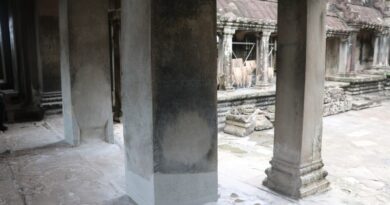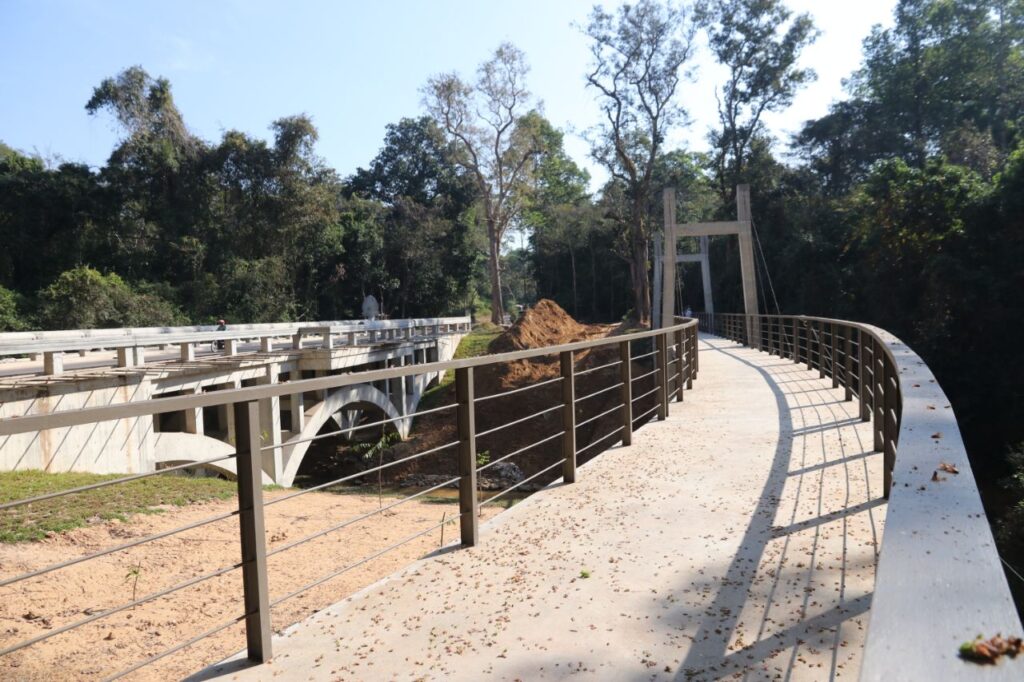អាជ្ញាធរជាតិអប្សរាបានសាងសង់ស្ពានផ្លូវកង់ស្របតាមស្ពានប្រាសាទតាកែវ ដើម្បីសម្រួលដល់ការជិះកង់ របស់ភ្ញៀវទេសចរក្នុងរមណីយដ្ឋានអង្គរឱ្យកាន់តែងាយស្រួល។
លោក សុខ សូសិលា អនុប្រធាននាយកដ្ឋានទឹក ព្រៃឈើ និងហេដ្ឋារចនាសម្ព័ន្ធ នៃអាជ្ញាធរជាតិអប្សរា បានឱ្យដឹងថា អាជ្ញាធរជាតិអប្សរាបានចាប់ផ្តើមសង់ផ្លូវកង់ក្នុងរមណីយដ្ឋានអង្គរនៅឆ្នាំ២០២០ ដើម្បីសម្រួលដល់ភ្ញៀវទេសចរដែលនិយមជិះកង់កម្សាន្ត។ ផ្លូវកង់ក្នុងរមណីយដ្ឋានអង្គរប្រវែងសរុបជាង ២៣គីឡូម៉ែត្រ ហើយក្នុងនោះក៏មានឆ្លងស្ទឹងចំនួន៤ទីតាំងផងដែរ។
ស្ពានផ្លូវកង់ប្រាសាទតាកែវ គឺជាទីតាំងមួយក្នុងចំណោម៤ទីតាំងខាងលើ ដែលអាជ្ញាធរជាតិអប្សរា សាងសង់សម្រួលដល់អ្នកជិះកង់ ដោយចង់បែងចែកឱ្យដាច់រវាងផ្លូវឬស្ពានធ្វើដំណើរទូទៅ និងផ្លូវកង់។ ស្ពាននេះមានទទឹង២.៥ម៉ែត្រ និងបណ្ដោយ៦៥ម៉ែត្រ។ ចំណែកស្ពានកង់៣ទីតាំងទៀត រួមមាន ស្ពានអង្គរ ស្ពានក្រាំងក្រូច និងស្ពាននាគព័ន្ធ។ ក្រៅពីនេះ ក៏មានស្ពានខ្នាតតូចឆ្លងកាត់២ទីតាំងទៀត ដូចជាកសិន្ធុយសោធរ និងអតីតទ្វារទឹកនាគព័ន្ធ។
គោលបំណងសំខាន់នៃការបង្កើតផ្លូវកង់ក្នុងរមណីយដ្ឋានអង្គរ គឺការចង់បែងចែកឱ្យដាក់ពីគ្នារវាងផ្លូវ ចរាចរណ៍ធម្មតា និងផ្លូវកង់ ដើម្បីលើកកម្ពស់កីឡាជិះកង់ ការកាត់បន្ថយគ្រោះថ្នាក់នៅ លើដងផ្លូវរវាងអ្នកជិះយានយន្ត និងអ្នកជិះកង់ ពិសេសកាត់បន្ថយផ្សែងយានយន្ត ដែលប៉ះពាល់ដល់ថ្មប្រាសាទ។
ចំពោះរចនាបថនៃការសង់ស្ពានកង់នេះ លោក សុខ សូសិលា បញ្ជាក់ថា បានជ្រើសរើសការរៀបចំបែបសាមញ្ញស្រដៀងនឹងធម្មជាតិជុំវិញ ដោយមិនបង្កើតអ្វីដែលថ្មីលេចធ្លោពេកទេ គឺស្របតាមគោលគំនិតរបស់ថ្នាក់ដឹកនាំថា ការអភិរក្សដើរស្របនឹងការអភិវឌ្ឍ។
ជាមួយគ្នានេះ លោក សុខ សូសិលា សំណូមពរឱ្យភ្ញៀវទេសចរ ចូលរួមលើកតម្កើងការជិះកង់ ឱ្យបានកាន់តែច្រើននៅក្នុងតំបន់រមណីយដ្ឋានអង្គរ ក្នុងបំណងដើម្បីសុខភាព ប្ដូរបរិយាកាសថ្មី ព្រោះថាការជិះកង់ធ្វើឱ្យយើងមានពេលគ្រប់គ្រាន់សម្រាប់ការទស្សនា ឬសិក្សាពីធម្មជាតិនៅជុំវិញ ពិសេសលុបបំបាត់ផ្សែងពុលដែលបង្កគ្រោះថ្នាក់ដល់ការអភិរក្សប្រាសាទ៕
អត្ថបទ៖ នាង សំណាង
រូបភាព៖ ភោគ ជា
APSARA National Authority has built a bicycle bridge along the bridge of Takeo Temple to facilitate the cycling of tourists in the Angkor site more easily.
Mr. Sok Soseila, Deputy Director of the Department of Water, Forestry and Infrastructure Management of the APSARA National Authority, said that the APSARA started building bicycle roads at the Angkor site in 2020 to facilitate tourists who enjoy cycling. The bike roads in the Angkor site have a total length of more than 23 kilometers, including four bridges.
Takeo Temple bicycle bridge is one of the four locations above which the APSARA National Authority built to accommodate cyclists who want to differentiate between the road or the general travel bridge and the bicycle road. The bridge is 2.5 meters wide and 65 meters long. The other three bicycle bridges include the Angkor, Kraing Krouch, and Neak Poan. Apart from this, there are also small bridges across two other places, such as the Yosothor moat and the former Neak Poan water gate.
The main purpose of establishing bicycle roads in Angkor is to separate the normal traffic roads and bicycle roads to promote cycling, reducing accidents on the road between motorists and cyclists especially to reduce vehicle exhaust that affects the temples.
As for the style of construction of the bicycle bridge, Mr. Sok Soseila stated that he chose a simple arrangement similar to the surrounding nature without creating anything new and prominent, in line with the management’s concept that conservation goes hand in hand with development.
At the same time, Mr. Sok Soseila suggested that tourists participate in promoting more cycling in the Angkor area to change the environment, because cycling gives us enough time to visit or study the surrounding nature, especially eliminate toxic fumes that are harmful to the conservation of the temple.
Article: Neang Samnang
Photos: Phouk Chea
Share:
Our Latest News

អាជ្ញាធរជាតិអប្សរាកំពុងអភិរក្ស និងជួសជុលជើងសសរនៅរួតបាកានប្រាសាទអង្គរវត្ត- APSARA National Authority is restoring pillars at the Bakan Tower, Angkor Wat- 05 June 2025
ក្រុមការងារនាយកដ្ឋានអភិរក្សប្រាសាទ និងបុរាណវិទ្យា នៃអាជ្ញាធរជាតិអប្សរា កំពុងអភិរក្ស និងជួសជុលជើងសសរនៅរួតបាកានប្រាសាទអង្គរ ដែលជើងសសរមួយចំនួនមានការពុកផុយ។




